
 |
ROTOVAP |
 |
The rotary evaporator is an instrument that is designed to allow you to distill a liquid under conditions of reduced pressure. Since the pressure within the system has been reduced, that means that the liquid can now distill at a lower temperature than it would at atmospheric pressure. This is a very safe and fast method of distilling flammable solvents. However our system will only work for solvents that would normally boil at temperatures less than 60°C at atmospheric pressure. The rotovap itself consists of the following parts: |
 |
a) a long condenser containing a distillation tube surrounded by a coil of glass tubing. This glass tubing will have cold water running through it to provide a cooling atmosphere for the gas as it is being distilled. (left) b) The condenser is hooked up to a water aspirator which
will allow you to evacuate the system. To close the system and thus activate
the vacuum, turn the stopcock knob at the far end of the rotovap to align
it with the vacuum (ie. turn until the arrow on the knob points straight
down towards the attached tubing ie. knob is pointing to the “ON”
position). The system is now under reduced pressure.
(below) |
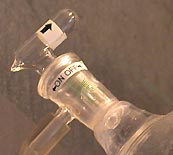 OFF OFF |
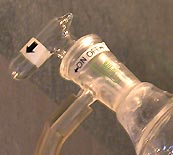 ON ON |
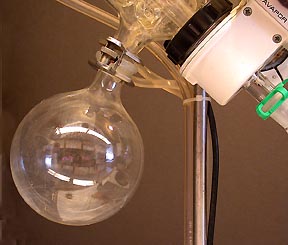 |
c) A large round collection flask is attached to the condenser to collect the distillate when it forms. (left) |
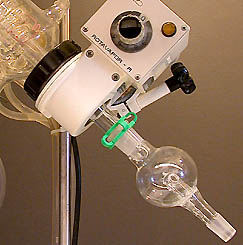 |
d) A distillation tube connects the condenser to the sample flask. There is a “trap” at the end of the distillation tube to prevent unwanted sample from splashing up into condenser. The distillation tube will carry the distilled solvent about halfway up into the condenser before this gas will encounter the coils filled with cold water. (left) |
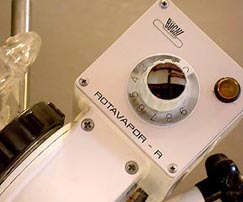 |
e) A rotary dial is included that will allow you to spin the sample flask (left) |
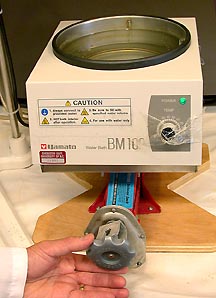 |
f) a hot water bath is included that can be raised by turning the knob on the jack below the water bath clockwise. This is used to heat the sample flask. (left) |
USING THE ROTOEVAPORATOR 1. Add your sample to be rotovapped into the RB flask. NOTE: your RB flask should never be more than half full with liquid when you attach it to the rotovap. If it is, you risk losing some of your sample! If you have too much liquid to evaporate, remove some until the flask is less than half full, rotovap away the liquid in the RB and then add the rest. Or you can use a hot water bath in the fumehood to boil away some of the excess solvent. |
|
2. Connect your RB flask to the trap on the end of the distillation
tube and secure this using the circular blue clip [NOTE: the blue clip has
two sides; the smaller circle goes just above the lip of the RB flask, on
the neck of the trap and the larger circle goes just below the lip of the
RB flask]. 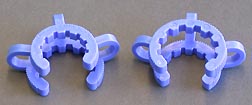 |
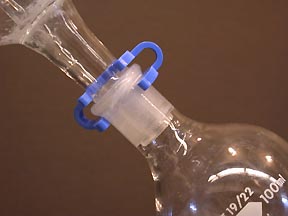 |
3. To close the system and thus activate the vacuum, turn
the stopcock knob at the far end of the rotovap to align it with the vacuum
(ie. turn until the arrow on the knob points straight down towards the
attached tubing ie. knob is pointing to the “ON” position).
The system is now under reduced pressure.
|
|
6. As the solvent evaporates, its vapour will go up the
trap into the distillation tube and exit about halfway up the condenser
coils. These coils are filled with cold water and thus the hot gas will
condense there. Very soon, you should notice liquid dripping off the coils
and collecting in the large condensate flask below the coils. NOTE: sometimes when you have a very small volume, you may not notice
any dripping from the condenser coils. If this happens, wait 1-2 minutes
and observe if there is any change in the RB flask. When the dripping
stops or you don’t notice any dripping off the coils for at least
30 seconds, you can stop the rotovap. You do this in the reverse order
from the way you started: |